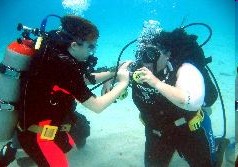The short answer is shipwrecks.
| [singlepic=111,400,300,,left] |
| The Bow of the Chaparra |
Here on the east coast we do not have the rocky shore and bottom found on the west coast. Our shore line is mostly sand, and for the most part the bottom is sand also. The continental shelf slopes out for 60+ miles before dropping off sharply. Sand and silt that washes out of our rivers and streams has deposited in this shallow area for thousands of years.
This sand does not provided shelter for fish or secure footing for large plants like kelp. The sand does provide a home for clams, scallops, and sand dollars, but the more interesting areas to dive are the shipwrecks.
There are an estimated 4000-5000 shipwrecks off the coast of New Jersey. (Many people are taken back by that statement.) Keep in mind that we have the port of New York to the north, and the port of Philadelphia to the south. Over the past 300 years there have been thousands of accidents in these waters. Further, during two world wars, the German submarine force spent a significant amount of time trying to stop the flow of supplies from the US to Europe. Many ships were sunk just miles off our beaches.
The older wrecks of wooden ships have been slowly eroded by the forces of nature. Storms, sand, rot, and marine invertebrates have nearly erase them. Still left are the stronger structural beams along with the anchor chain, and machinery used to lift it.
New steel ships quickly fall victim of rust. Many of these ships are now jumbles of steel rubble and hull plates strewn on the sandy bottom. Again stronger or reinforced portions of the ship hold up better with time. Engines, boilers, propellers, and pipes are often recognizable. Metals like coper, brass and bronze stand up better to salt waters corrosive effects.
Even in this state of decay, these wrecks provide shelter for marine creatures. Filter feeders like mussels, sponges and anemones attach to the wreckage for support. Lobsters and crabs burrow under the wreckage for protection. Schools if fish surround the wrecks. Some are looking for shelter, others are looking for food.
 This is a another common question along with: How do you learn to dive? How long does it take?
This is a another common question along with: How do you learn to dive? How long does it take?